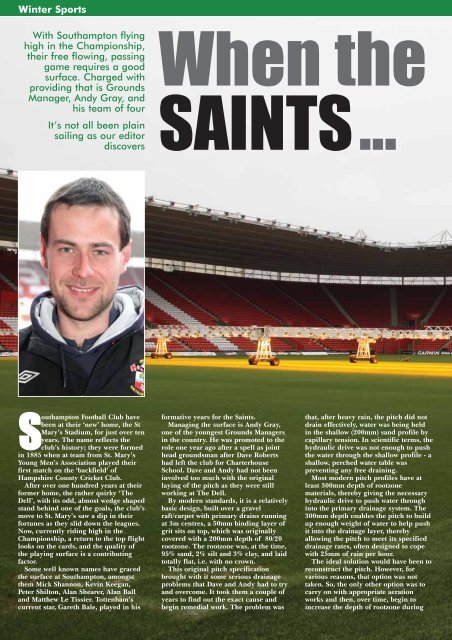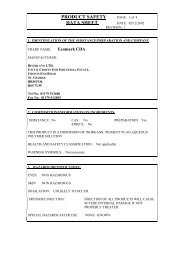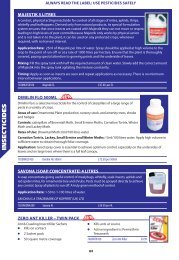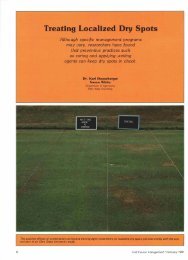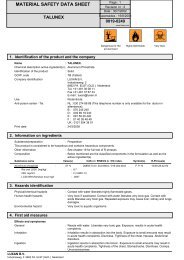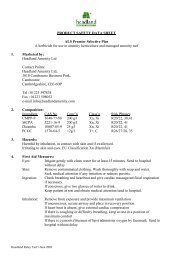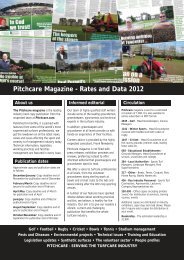these Open Championship Clubs choose to relief grind - Pitchcare
these Open Championship Clubs choose to relief grind - Pitchcare
these Open Championship Clubs choose to relief grind - Pitchcare
You also want an ePaper? Increase the reach of your titles
YUMPU automatically turns print PDFs into web optimized ePapers that Google loves.
Winter Sports<br />
With Southamp<strong>to</strong>n flying<br />
high in the <strong>Championship</strong>,<br />
their free flowing, passing<br />
game requires a good<br />
surface. Charged with<br />
providing that is Grounds<br />
Manager, Andy Gray, and<br />
his team of four<br />
It’s not all been plain<br />
sailing as our edi<strong>to</strong>r<br />
discovers<br />
Southamp<strong>to</strong>n Football Club have<br />
been at their ‘new’ home, the St<br />
Mary’s Stadium, for just over ten<br />
years. The name reflects the<br />
club’s his<strong>to</strong>ry; they were formed<br />
in 1885 when at team from St. Mary’s<br />
Young Men’s Association played their<br />
first match on the ‘backfield’ of<br />
Hampshire County Cricket Club.<br />
After over one hundred years at their<br />
former home, the rather quirky ‘The<br />
Dell’, with its odd, almost wedge shaped<br />
stand behind one of the goals, the club’s<br />
move <strong>to</strong> St. Mary’s saw a dip in their<br />
fortunes as they slid down the leagues.<br />
Now, currently riding high in the<br />
<strong>Championship</strong>, a return <strong>to</strong> the <strong>to</strong>p flight<br />
looks on the cards, and the quality of<br />
the playing surface is a contributing<br />
fac<strong>to</strong>r.<br />
Some well known names have graced<br />
the surface at Southamp<strong>to</strong>n, amongst<br />
them Mick Shannon, Kevin Keegan,<br />
Peter Shil<strong>to</strong>n, Alan Shearer, Alan Ball<br />
and Matthew Le Tissier. Tottenham’s<br />
current star, Gareth Bale, played in his<br />
When the<br />
SAINTS...<br />
formative years for the Saints.<br />
Managing the surface is Andy Gray,<br />
one of the youngest Grounds Managers<br />
in the country. He was promoted <strong>to</strong> the<br />
role one year ago after a spell as joint<br />
head groundsman after Dave Roberts<br />
had left the club for Charterhouse<br />
School. Dave and Andy had not been<br />
involved <strong>to</strong>o much with the original<br />
laying of the pitch as they were still<br />
working at The Dell.<br />
By modern standards, it is a relatively<br />
basic design, built over a gravel<br />
raft/carpet with primary drains running<br />
at 3m centres, a 50mm binding layer of<br />
grit sits on <strong>to</strong>p, which was originally<br />
covered with a 200mm depth of 80/20<br />
rootzone. The rootzone was, at the time,<br />
95% sand, 2% silt and 3% clay, and laid<br />
<strong>to</strong>tally flat, i.e. with no crown.<br />
This original pitch specification<br />
brought with it some serious drainage<br />
problems that Dave and Andy had <strong>to</strong> try<br />
and overcome. It <strong>to</strong>ok them a couple of<br />
years <strong>to</strong> find out the exact cause and<br />
begin remedial work. The problem was<br />
that, after heavy rain, the pitch did not<br />
drain effectively, water was being held<br />
in the shallow (200mm) sand profile by<br />
capillary tension. In scientific terms, the<br />
hydraulic drive was not enough <strong>to</strong> push<br />
the water through the shallow profile - a<br />
shallow, perched water table was<br />
preventing any free draining.<br />
Most modern pitch profiles have at<br />
least 300mm depth of rootzone<br />
materials, thereby giving the necessary<br />
hydraulic drive <strong>to</strong> push water through<br />
in<strong>to</strong> the primary drainage system. The<br />
300mm depth enables the pitch <strong>to</strong> build<br />
up enough weight of water <strong>to</strong> help push<br />
it in<strong>to</strong> the drainage layer, thereby<br />
allowing the pitch <strong>to</strong> meet its specified<br />
drainage rates, often designed <strong>to</strong> cope<br />
with 25mm of rain per hour.<br />
The ideal solution would have been <strong>to</strong><br />
reconstruct the pitch. However, for<br />
various reasons, that option was not<br />
taken. So, the only other option was <strong>to</strong><br />
carry on with appropriate aeration<br />
works and then, over time, begin <strong>to</strong><br />
increase the depth of rootzone during


